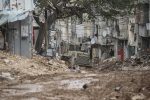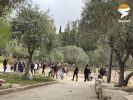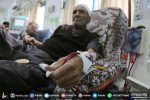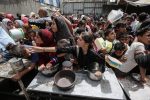The opening of the US embassy in Jerusalem on 14 May has rubbed salt into gaping wounds.
As “presidential adviser” Ivanka Trump stood gleefully next to a triumphant Benjamin Netanyahu at the heart of the illegally annexed city Israel was engaging in yet another massacre less than 100km to the southwest. Dozens of people were killed in Gaza and thousands injured in the six weeks of the Great Return March between Land Day and Nakba Day and many of the injured still languish in Gaza’s ill-equipped hospitals.
The siege of Gaza whose population largely comprises refugees continues to choke the region in what has been described as an “incremental genocide”.
Ongoing Nakba
This is what Palestinians mean when they say the Nakba is ongoing. The wrongs against us were not perpetrated just once in 1948; they continue to this day with more displacement more land theft and more mass killings.
As has been happening after every massacre for a few years now protests erupted globally while a growing number of people of conscience publicly denounced Israel’s actions and announced support for the Boycott Divestment and Sanctions (BDS) solidarity campaign.
The protests are necessary venues to express solidarity with Palestinians and to show politicians that the public does not approve of this latest offensive move. The public denunciations by artists of Israel’s criminality are welcome and long-overdue steps in declaring Israel as a pariah state rather than an attractive destination for culture and tourism.
As Electronic Intifada co-founder Laurie King and I asked in a 2011 editorial: Why would one be critical of artists such as Beyonce Usher and Mariah Carey – all three of whom gave private performances for the Gaddafis – when one thinks nothing of the likes of Madonna and Lady Gaga cosying up to Netanyahu and sometimes literally wrapping themselves in the Israeli flag while many others defend Israel as it openly embraces apartheid and ethnic cleansing?
But today with Israeli politicians’ brazen declaration that there are no innocent protesters in Gaza and that all marchers are legitimate targets and with Israeli citizens repeatedly declaring their support for the killing of Palestinians we are finally seeing cracks in Israel’s mask in the facade of democracy with which it has fooled much of the West.
Old imperial order
However we cannot relax just yet. Instead we must keep exposing Israel so that it does not recover from the momentary criticism as it has done time and again after previous massacres and the protests that followed them.
The Nakba Day massacre and the inauguration of the new US embassy do not constitute an aberration. Analysts who argue that the US embassy move to Jerusalem is a continuation of its long-standing policy in the Middle East beginning in 1967 rather than a departure from it are correct.
I would add that it is a continuation not just of US policy but of an even older imperial order – indeed the old imperial order that gave birth to the US. The past century of Palestinian history has been a painful loop of extreme injustice imposed upon indigenous people followed by uprisings which in turn are violently suppressed until the people rise up yet again demanding justice.
The revolts including the 1936-39 uprising against the British Mandate and the intifadas starting in 1987 and 2000 have taken many forms from armed insurrection to peaceful protests. They have invariably been met with disproportionate violence on the part of the colonial oppressor beginning with England which first imposed martial law and crafted many of the measures Israel still employs to this day in its discrimination against Palestinians to the full-blown massacres Israel now routinely engages in.
Those massacres are today made possible by the US which gives Israel the necessary financial and diplomatic support to act with impunity. In his conclusion to the groundbreaking 1978 book Orientalism Edward Said wrote that the US ascendency to global dominance put it in the position Great Britain once had when it arrogantly claimed that “the sun never sets” on the British empire. The US embassy in Jerusalem illustrates Said’s wisdom years after his untimely death.
Vision beyond protests
Over the past few years another regular feature of massacres has emerged – namely the declaration that “this is a turning point”. Most recently the Great Return March has been compared to the crossing of the Edmund Pettus bridge in the US south while the Nakba Day massacre has been described as the Palestinian Sharpeville.
However the Great Return March will only become a turning point if we make it so. If we want the pattern to change we need to organise with a vision beyond the protests. For now most protests have been spontaneous uprisings against injustice with little planning for what comes after we have gathered on street corners and in public parks to scream our pain our outrage and our solidarity.
As we move past the centenary of the Balfour Declaration and the 70th anniversary of the Nakba amid the renewed hubris of today’s imperial leaders it is imperative that we focus on planning for the future rather than merely protesting.
Ultimately it is not the scope of the massacre that determines whether it is a turning point. Rather it is how well we sustain our mobilising and organising so that this is not just another episode in a long string of injustices.
It is incumbent on us to honour Palestinian resistance not by simply reading the names of the dead but by mobilising organising and strategising to ensure this massacre is not the latest but the last.
– Nada Elia is a diaspora Palestinian writer and political commentator. Her article was published in the Middle East Eye.











